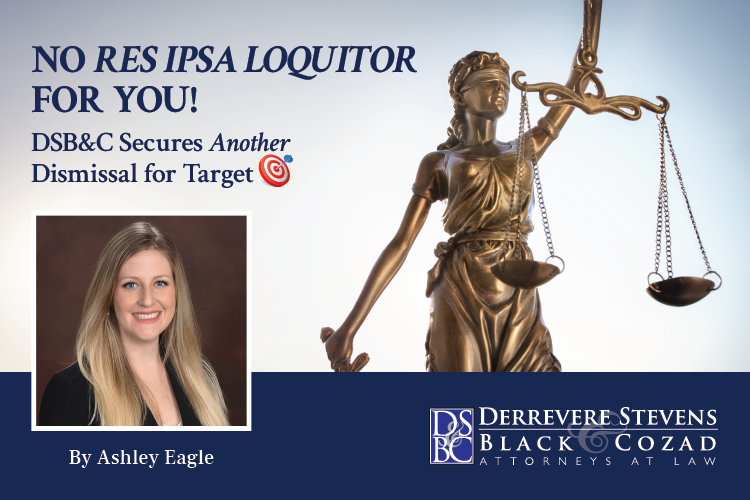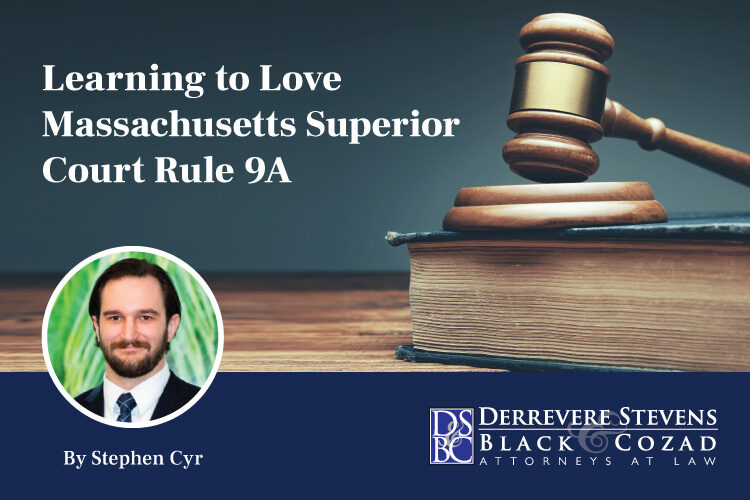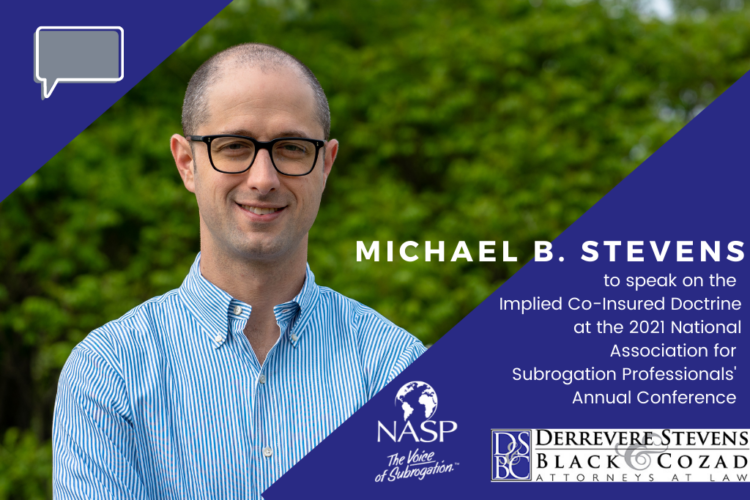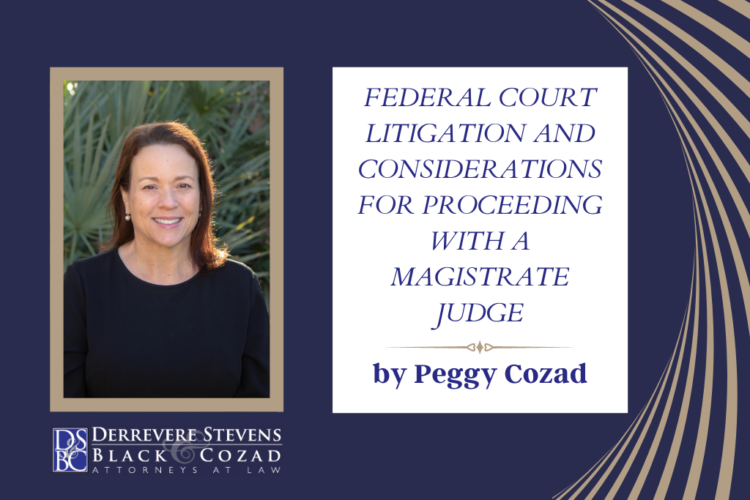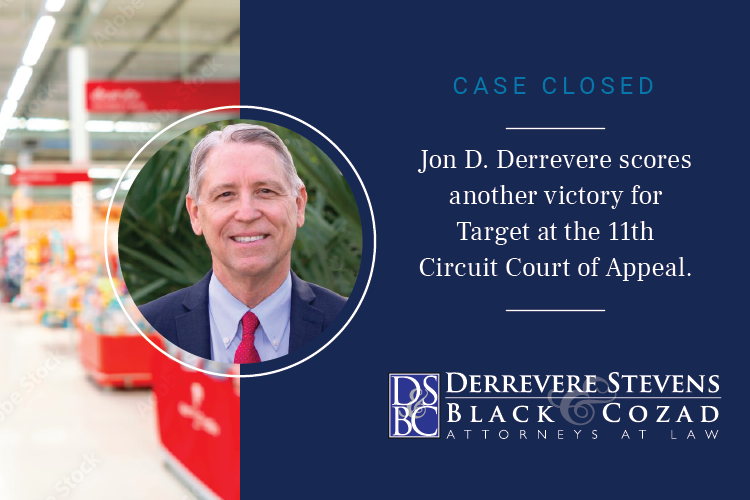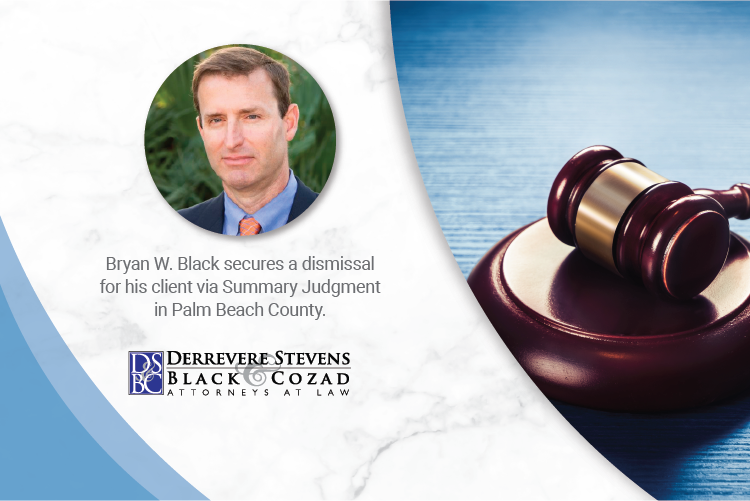September 30, 2021
No Res Ipsa Loquitor for You: DSB&C Secures Another Dismissal for Target
In Urena v. Target Corp., Plaintiffs, as parents and natural guardians of their minor child, claimed their daughter sustained physical injuries when she struck an end cap in Target’s Palm Beach Lakes store while shopping with her mother and grandmother.
August 23, 2021
Learning to Love Massachusetts Superior Court Rule 9A
Most Massachusetts attorneys have likely heard other attorneys, or have themselves bemoaned one of many Massachusetts-specific rules or requirements that tend to frustrate practicing attorneys: the need for blue ink signatures; the need for original summonses to file with the court; or the dreaded 9C conference—the list goes on.
However, few rules are as frustrating to many as Superior Court Rule 9A. While I have admittedly had my duels with the somewhat onerous requirements of this rule, over time my once sworn enemy has become my dear friend.
The predictability and routine nature of Superior Court Rule 9A can be a boon to any attorney so long as they break down the rule and make it a mechanical process that everyone can follow. In the next few steps, I am going to walk through the basic requirements for the rule and outline a few additional helpful tips. This is ONLY applicable in Superior Court so don’t go filing 9A Packages in district court or risk the ire of district court attorneys, clerks, and judges alike.
A few caveats before I begin: (1) do yourself a favor and download the PDF if you have not reviewed the rule before, it is far easier to read…at least for me; (2) this is not an exhaustive breakdown of Superior Court Rule 9A…this is an eight (8) page rule, review it, double-check it, triple-check it, until you are comfortable with its ins and outs; (3) I am not going to outline the requirements under 9A for dispositive motions or Summary Judgment Motions—be sure to review those specific requirements…there are a number of them… I may cover these in a separate post; and (4) make sure you check the rules often—Rule 9A is one of the more frequently updated rules, do not get your motion rejected because you failed to comply with a new requirement or update.
- Step 1: Determine if you need to talk to opposing counsel first
- Per the updated and fairly in-depth requirements under Superior Court Rule 9C, many motions filed in Superior Court now require attorneys to “confer” with opposing counsel in advance to filing a Motion. Be sure to review Superior Court Rule 9C closely. If all else fails, it is never a bad idea to talk to opposing counsel. If you do confer, draft a 9C Certificate and include it with your 9A Package…it never hurts. Also, you can confer after you have drafted the Motion/Memorandum discussed in Step 2.
- Step 2: Draft your Motion AND Memorandum!
- Yes, that is right, you need both. Per Superior Court Rule 9A(1) you need both a Motion and then a separate Memorandum of Law stating the reasons why said Motion should be granted. I know what everyone will say, “but I have filed a Motion without a Memorandum and it was granted.” And you are not wrong, but what works and what are best practices will always be two different animals. As they say, “thems the rules.” My personal recommendation, if you must file a Motion without a Memorandum—make sure it is either unopposed or a joint motion.
- Step 3: Serve your Motion, Memorandum, and Certificate of Service
- When you send your Motion and Memorandum to opposing counsel, be sure to include a Certificate of Service—you will need this later for the 9A Package. Per 9A(b)(1)(iii), Electronic Service, which is my preferred method, is permitted. Make sure to include in said Certificates of Service “served via email” so that scanned signatures can be accepted by the Court.
- Step 4: Waiting Game (give it 13 days)
- For typical Motions (i.e. NOT discovery or dispositive motions) you have ten (10) days after serving the motion/memo to withdraw or file the same, but an additional three (3) business days is permitted for service of the Opposition. This portion is somewhat convoluted and confusing. Simplified, just wait thirteen (13) days for opposing counsel to serve you with their opposition and you should not have any issues.
- Step 5: 9A Package (two potential options)
- Option 1 (No Opposition): If opposing counsel doesn’t serve you with an opposition within thirteen (13) days, you can now get your 9A package ready for filing. You will need to include the following in the 9A package (1) Motion; (2) Memorandum; (3) Original Certificate of Service—from Step 3; (4) Notice of Filing; (5) Affidavit of Compliance with 9A; (6) NEW Certificate of Service which serves Opposing Counsel with your Notice of Filing and Affidavit of Compliance with 9A. Send it to the Clerk and wait for the court to grant the same…unless you failed to follow the rule!
- Option 2 (Opposition – “to reply, or not reply”): So you got an opposition. You can either choose to draft a reply or get your 9A package ready. Per the rule, a Reply should only address NEWLY raised issues in the Opposition. Do not be that attorney that always files a Reply, though it is a crime we have all been guilty of. If new issues are raised, then draft one, otherwise get that 9A Package ready! In this instance your 9A Package will include the following: (1) Motion; (2) Memorandum; (3) Original Certificate of Service—from Step 3; (4) Opposition; (5) Notice of Filing; (6) Affidavit of Compliance with 9A; and (7) NEW Certificate of Service which serves Opposing Counsel with your Notice of Filing and Affidavit of Compliance with 9A.
- Step 6: Additional Helpful Tips
- Always, always, always, send the 9A Package with a letter that outlines in order the documents included therein. This will make the job of the clerks easier, and anything you can do to make their lives easier will come back tenfold.
- IF, you are filing/serving hard copies, i.e. not exchanging the Motion documents electronically, and the documents are physically signed with a pen. Make sure to sign them in blue ink and retain the originals. Serve opposing counsel with copies of everything. This is needed so you can then file the originals with the court in your 9A package.
- If you are served with a Motion and opposing counsel fails to comply with 9A, do not expect that to kill their motion. Prepare as if the court will hear arguments, and get your opposition into the court. I have seen so many cases get muddied because someone failed to comply with 9A, the court didn’t notice, the court granted the motion and here you are trying to wind the clock back.
- Finally, if you have a good grasp of Rule 9A, be sure to educate others, paralegals, new associates, legal secretaries, etc. This can be helpful to both make your life easier when it comes to serving and filing motions, and a good way to familiarize yourself further with the rules.
Well, there you have it. In my effort to break down the rule, I wrote another 1,000+ words about it. C’est la vie. Take your time. Check the rules. Have some fun, and at the end of the day, I am sure 9A will grow on you…like some strange legal fungus.
If you have any questions or the desire to chat about the wild world of Massachusetts Rules please feel free to click HERE and reach out.
August 12, 2021
Hurry Up and Wait
Subrogation and workers compensation, together, normally are not a topic of conversation at many events or family gatherings. However mundane as it sounds, if you are a workers’ compensation carrier or injured worker, you may want to learn more as Florida law allows for other parties, not just the injured worker, to recover from the third-party who caused the injury.
July 19, 2021
Michael B. Stevens to Speak on the Implied Co-Insured Doctrine at the 2021 National Association for Subrogation Professionals’ Annual Conference on November 7-8
DSB&C’s Managing Partner, Michael B. Stevens, has been selected by the National Association for Subrogation Professionals to speak at this year’s annual conference. Michael will be speaking on the topic of the Implied Co-Insured Doctrine which he has litigated in various states and in Florida all the way to the Florida Supreme Court. The conference will be virtual this year.
Click here for more information about attending the conference.
July 2, 2021
Federal Court Litigation and Considerations for Proceeding with a Magistrate Judge
As the court system seeks to return to its new post-pandemic normal, DSB&C remains committed to legal excellence in representing clients. The goal in litigated cases is to obtain the fair and just determination in every case. In Federal Court, consent to a magistrate judge may be a tactical advantage to consider. 28 U.S.C. Chapter 43 sets forth the qualifications, training, and jurisdiction of a magistrate judge. Appointment of a magistrate judge is made without regard to political affiliation and must be confirmed by the district court judges. The statute ensures only the most experienced and highest caliber are selected. Consenting to a magistrate judge allows all issues of the case to be developed and determined by one judge rather than the usual practice of proceeding before the magistrate judge for discovery issues and the district judge for trial.
Because magistrate judges do not preside over felony criminal trials, they have greater flexibility in scheduling deadlines and trial. This affords greater opportunity to uncover complex factual issues and delve into the intricacies of legal causation and damages. Consent to the magistrate judge helps the court system to utilize its resources as efficiently as possible while ensuring proficient and highly qualified judgeship from inception to resolution of a case. The attorneys at DSB&C are experienced in all aspects of federal court litigation. Our attorneys consider the client’s right to proceed before a magistrate judge and provide thoughtful recommendations on a case-specific basis.
Click here to email me anytime if you have additional questions.
June 14, 2021
Jon D. Derrevere scores another victory for Target at the 11th Circuit Court of Appeal
The premises liability team of DSB&C of our West Palm Beach office successfully defended an appeal in the Eleventh Circuit Court of an Order granting Final Summary Judgment. In Espinoza v. Target Corp., 843 F. App’x 168, (11th Cir. 2021), Plaintiff claimed physical injuries to her head, neck, back, and shoulder; she also claimed damages for psychological injuries and memory loss related to a fall in a large puddle of milk in the stationary department of the Boynton Beach store. The central issue on appeal was whether the evidence supported an inference of constructive notice under Fla. Stat. 768.0755 (2010).
The Per Curiam Opinion affirmed summary judgment in favor of Target as Plaintiff’s inferences regards the size of the puddle, the temperature of the milk, and the policy and timing of a last inspection did not establish how long the puddle had been on the floor to charge Target with constructive notice of its existence. The Court ruled as a matter of law Target was not liable for any of Plaintiff’s claimed injuries. A proposal for settlement was filed early in the case which provided the client the opportunity to recover costs and fees for successful defense of this lawsuit. Our team is well prepared to handle all aspects of the premises liability lawsuit including summary judgment, appeals, and trials.
You can read the opinion by clicking here.
June 1, 2021
Derrevere Stevens Black & Cozad Taps Michael B. Stevens as its New Managing Partner as the Firm Continues its Technological and Geographical Expansion Beyond Florida and into New England
June 1, 2021 – (West Palm Beach, Florida) —- Derrevere Stevens Black & Cozad (“DSB&C”) announced today that Michael B. Stevens has been appointed Managing Partner of the firm, effective June 1, 2021. Michael is the firm’s first Managing Partner to succeed the founding and outgoing Managing Partner, Jon D. Derrevere.
Having made Partner at DSB&C before the age of 30, Michael is no stranger to seizing upon opportunities whenever they are presented. Five years ago, Michael shook the firm from its quiet and content comfort zone in Florida when he slowly began expanding the firm’s practice into New England. Convinced that there were opportunities being missed and prospective clients in need of the firm’s services, Michael began splitting time between South Florida, Vermont, and Massachusetts to explore growth to the north. Within four short years, the firm now boasts four full time attorneys in Vermont and Massachusetts focusing on insurance subrogation to complement the 19 attorneys on its roster in South Florida. Demand continues to outpace supply which has the firm looking to continue its hiring spree well into the summer.
Serendipitously, it was Michael’s push into the north that positioned DSB&C to come through the pandemic stronger than it went into it. When Michael arrived in Vermont at the beginning of 2017, the technological infrastructure did not exist at the firm to allow one of its attorneys to interface with the firm’s database and personnel in a meaningful way. Long before the terms “Zoom” and “Teams” were commonplace in everyone’s daily routines, Michael created new process to allow employees to communicate with one another when they were not in the office. Cameras were provided to everyone on Michael’s team to allow for visual interaction on a daily basis, regardless of where the person was located. The firm shifted the majority of its case management practice to the cloud which untethered the employees from the brick-and-mortar server in West Palm Beach and allowed for unlimited scalability.
In March of 2020 when the pandemic hit the world hard and everyone pivoted to remote platforms, DSB&C was unphased. “It wasn’t as easy as flipping a switch, but we were ready. One partner meeting over the March 13th weekend and two moving days with a dedicated staff the following week made the transition seamless. But for hearing the laughter of children or a dog letting everyone know that the mailperson had arrived in the background of a phone call, our clients were no wiser that anything had changed on our end. We got lucky on the timing. Had the pandemic struck even one year earlier, I am not sure what would have happened,” said Michael. “As they say, better to be lucky than good.”
Over the past year, the firm has seen tremendous growth in all areas. While its insurance defense roots have continued to be the steady heartbeat of the firm, insurance subrogation is on pace to take over as the firm’s number one revenue sector in the next year. Having taken the firm’s subrogation division from a two-person team in West Palm Beach to one boasting 15 employees in four different states, Michael’s partners are looking to him to help nurture the firm’s continued long-term growth. “I am excited for this new opportunity and the faith my partners have placed in me.”
With this new role, Michael will be overseeing the day-to-day management of DSB&C with an emphasis towards leveraging the firm’s talent and technological prowess. “Anyone who thinks the legal industry is going back to the days of 30 lawyers gathering in a room for 5 minutes with a Judge on motion calendar hasn’t been paying attention this past year. Everyone benefits from virtual appearances. Clients pay less in fees and costs, and attorneys are less stressed by not needing to spend hours on the road to appear in person. Most people won’t admit it, but I know it’s not just me that loves getting to use my own bathroom most days – and let’s not forget how much we are helping the environment by leveraging this technology. Less car rides, and less plane rides means less carbon footprint. You don’t have to want to embrace a tree in Vermont to know that every little bit helps,” says Michael. “Beyond being good for the environment and business, helping the firm leverage technology also means more time with your family and doing the things that you love. There is no point in working this hard to not be able to enjoy the fruits of your labor with those that are important to you.”
With the overwhelmingly positive success of the firm’s work from home program this past year, DSB&C made the decision to make the program permanent. “If you want to work from home and can do so as a productive member of our firm, then you shall have that privilege,” said Michael. “Our employees are happier working from home. Why would we want to mess with that?”
Michael recently relocated to South Burlington, Vermont with his wife Amanda, and their two children. When he isn’t fighting the good fight for his clients in a courtroom, he enjoys identifying and testing out the best food in the cities he visits, hiking, skiing, and being the only Florida Panthers’ fan in all of New England.
April 14, 2021
Bryan W. Black Obtains Final Summary Judgment in Personal Injury and Property Damage Case involving Certified Mold Assessor and Indoor Air Quality Testing.
April 13, 2021 – Haskett, et. al. v. Hibiscus Springs Rental Homes, et. al. This action arises out of claims asserted by four (4) Plaintiffs against a Rental Home company, Property Management company, various individual employees and a Certified Mold Assessor & Air Quality Testing Company (“Defendant”). Plaintiffs filed their initial complaint in February 2020 asserting that a window at the Subject Rental Residence was leaking and despite pleas to the rental complex, continued to leak for a two year period. A mother, adult daughter and the daughter’s two boys allegedly developed health conditions as a result of exposure to toxic mold. Sometime in 2018, Plaintiffs noticed that the paint was bubbling and coming off the wall under the front bedroom window, revealing what appeared to be mold. Plaintiffs testified that they attempted to clean the mold but ultimately hired a mold testing company to test the conditions. After the mold testing company inspected and tested the conditions of the Subject Residence, they concluded that there were high levels of mold present in the Subject Residence. Upon receiving this information, Plaintiffs left the residence and moved into a hotel. Plaintiffs also left many of their personal belongings in the home, as they were under the impression that their personal effects were contaminated by mold. Thereafter, Plaintiffs only returned to the Subject Residence once to remove limited items from the garage and return the keys for the Subject Residence to the rental complex.
It was not until after Plaintiffs left the Subject Residence and returned the keys to the Management Company for the rental complex, that Defendant Certified Mold Assessor & Air Quality Testing Company was asked by the rental complex to perform Indoor Air Quality Testing at the Subject Residence. Defendant set up its equipment, turned it on, sampled the air at the Subject Residence and then left the property. Thereafter, Defendant provided the rental complex a copy of its report and lab results. Defendant had absolutely no communications with Plaintiffs before, during or after visiting the Subject Residence.
During litigation of the case, Defendant served all the Plaintiffs with requests for admissions and deposed the two (2) primary Plaintiffs (mother and adult daughter). Both testified that the Plaintiff did not contract, pay, rent, communicate, retain, or rely upon any representations made by the Defendant. Further, Plaintiffs testified that they did not know who Defendant was or what Defendant did with regard to the Subject Residence. Plaintiffs solely relied upon their own mold testing company when deciding to leave the Subject Residence and abandon their personal property, all of which occurred prior to Defendant’s first and only visit to the Subject Residence.
After a review of the record evidence, pleadings, answers to interrogatories and testimony, the Trial Court ruled that there was no genuine issue of material fact and Defendant was entitled to Final Summary Judgment as a matter of law. The duty element of negligence is a threshold legal question; if no legal duty exists, no action for negligence may lie. Florida courts have consistently held that the issue of whether a defendant owes a duty to a plaintiff is a question of law for the courts to decide. The Court also found that the Plaintiffs third-party beneficiary claim likewise failed as the record evidence unrefutably established there was no contract, no breach of a non-existent contract and no resulting damages. Nothing Defendant did, or did not do, would have, as a matter of law, created a duty between Defendant and Plaintiffs; nor could anything Defendant did, or did not do, be deemed the proximate cause of Plaintiffs’ alleged damages.
The matter is not final, and subject to change, until the expiration of the relevant periods for any motion for rehearing and/or the time for appeal has concluded.
December 13, 2019
Fourth District Court of Appeals Affirms Summary Judgment in Construction Defect Case.
January 15, 2021 Update – Bryan W. Black, Esq.
In June 2020, at the Fourth District Court of Appeals, Appellant/Plaintiff sought plenary review of the final “Order on Defendant’s Motion for Final Summary Judgment”. Appellant argued that (1) the lower court erred in granting final summary judgment in favor of Appellee/Defendant since failure to comply with the notice requirement of Fla. Stat. 558.004 is not dispositive of an action requiring dismissal with prejudice and (2) that the lower court erred in granting final summary judgment in favor of Appellee since Appellant substantially complied with the notice requirement of Fla. Stat. 558.004. Appellee/Defendant timely responded with its Answer Brief describing how “Plaintiff has no evidentiary basis for a claim for damages and has no disputed issues of fact to be determined by the jury” pursuant to Fla. Stat. 558.004(11).
On January 14, 2021, the Fourth District Court of Appeals Affirmed Per Curiam the Trial Court’s ruling. The Fourth District also granted Appellee’s Motion for attorney fees conditioned on the Trial Court’s determination that Appellee is entitled to fees under section Fla. Stat. 768.79. The ruling is not final until disposition of timely filed motion for rehearing.
Case Description:
Boca Raton, Florida Homeowner alleged in a Complaint that Defendant Roofer’s Stone-Coated Steel Roof and flat deck TPO installation was defective, violated Florida Building Code, violated workmanship standards and breached its Contract. The defective installation allegedly resulted in significant water and mold damage to the home’s interior. Homeowner allegedly suffered compensatory damages in excess of $100,000, incidental and consequential damages, and sought attorney’s fees.
Defendant moved for Final Summary Judgment arguing that Plaintiff failed to provide Defendant with the mandatory statutory Notice and Opportunity to Repair/Cure, as required by Florida Statute §558.004 and, therefore, pursuant to Florida Statute §558.004(11), Plaintiff was prohibited from going to trial against Defendant on any “unnoticed” defects. After hearing argument, the Court found that Plaintiff failed to comply with Fla. Stat. §558.004(1)(a), and pursuant to Fla. Stat. §558.004(11) the court shall allow the action to proceed to trial only as to alleged construction defects that were noticed and for which the claimant has complied with this chapter and as to construction defects reasonably related to, or caused by, the construction defects previously noticed. As a result of Plaintiff’s failure to comply with the mandatory requirements, Plaintiff had no evidentiary basis for a claim for damages and had no disputed issue of fact to be determined by the jury. Therefore, Final Judgment in favor of Defendant was granted.
December 2, 2019
A Win for Subro in a Florida Commercial Landlord/Tenant Dispute
On February 7, 2015, a fire ripped through a 5 Napkins Restaurant on South Florida’s popular outdoor retail strip on Lincoln Road in South Beach. The damages to the building were extensive and ultimately caused the restaurant to close. Michael B. Stevens, Esq., and Mary Grecz, Esq., from Derrevere Stevens Black & Cozad filed a subrogation lawsuit on behalf of the landlord’s carrier, Zurich American Insurance Company, against a number of contractors involved with the maintenance and installation of the hood system, fire suppression system, and its insured’s tenant, Puccini, LLC. The tenant immediately moved to dismiss the Complaint on the basis that, while not a named insured under Zurich’s insurance policy, they should be considered an implied co-insured and, therefore, Zurich should be barred from subrogating against them. The trial court ultimately agreed with the tenant and dismissed Zurich’s lawsuit with prejudice. An appeal was then taken by Zurich to the Third-District Court of Appeal.
On appeal, Zurich’s primary argument was that the trial court had used the wrong standard to evaluate whether the tenant should be considered an implied co-insured under the Zurich policy. In dismissing the Complaint, the trial court had relied heavily on the fact that part of the tenant’s rent was used to pay a portion of the premiums for the Zurich policy. The trial court all but ignored the remainder of the lease which placed the risk of loss for a fire on the tenant and never shifted it back to the landlord. The Third-District Court of Appeal, in reversing the trial court, utilized the “Case-By-Case” approach, and found that when looking at the lease as a whole, even though a portion of the premium was paid for with the tenant’s rent, it was clear that the intent of the parties was for the tenant to bear the risk of loss in the event of a fire. The tenant thereafter sought review by the Florida Supreme Court which ultimately declined jurisdiction on September 10, 2019, thereby sending the case back down to the trial court for Zurich to continue its pursuit of the tenant.

